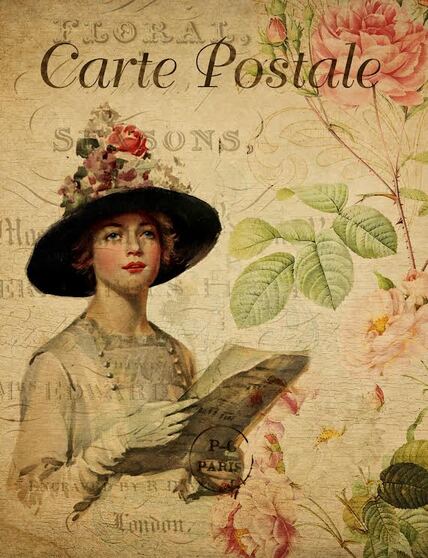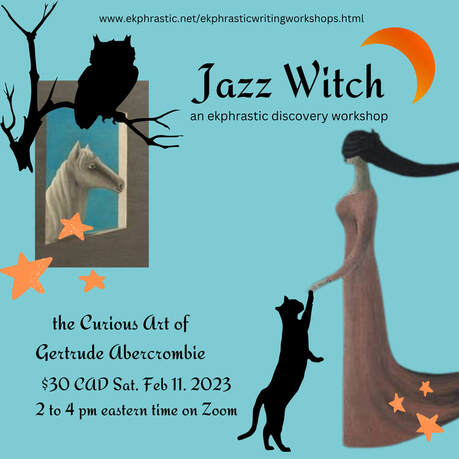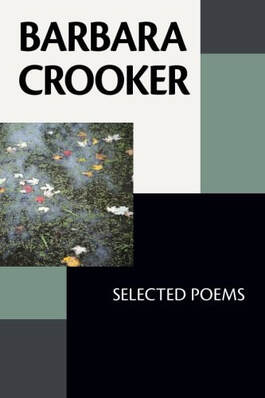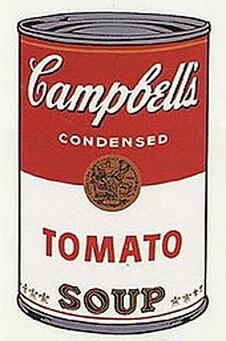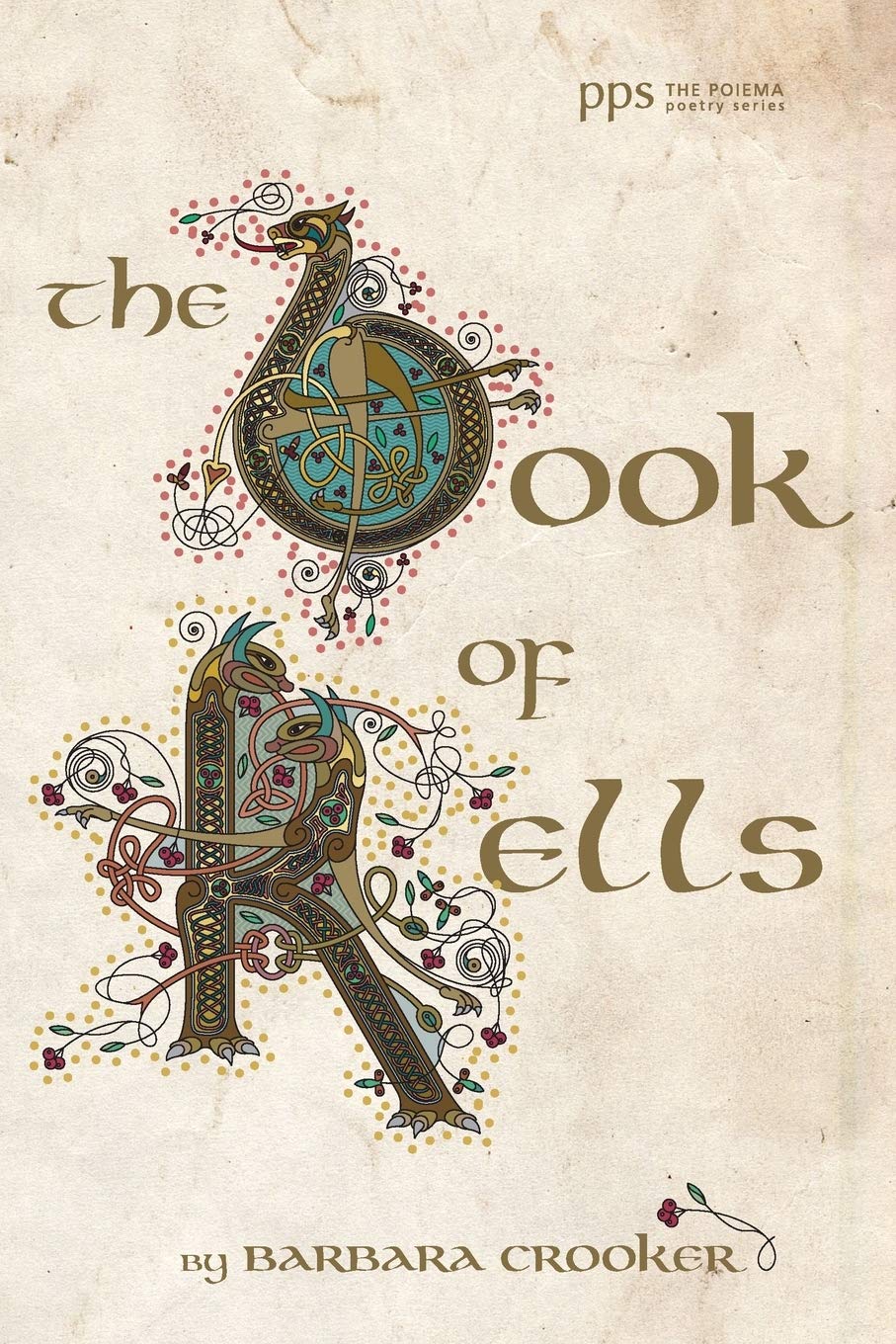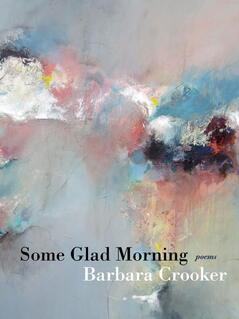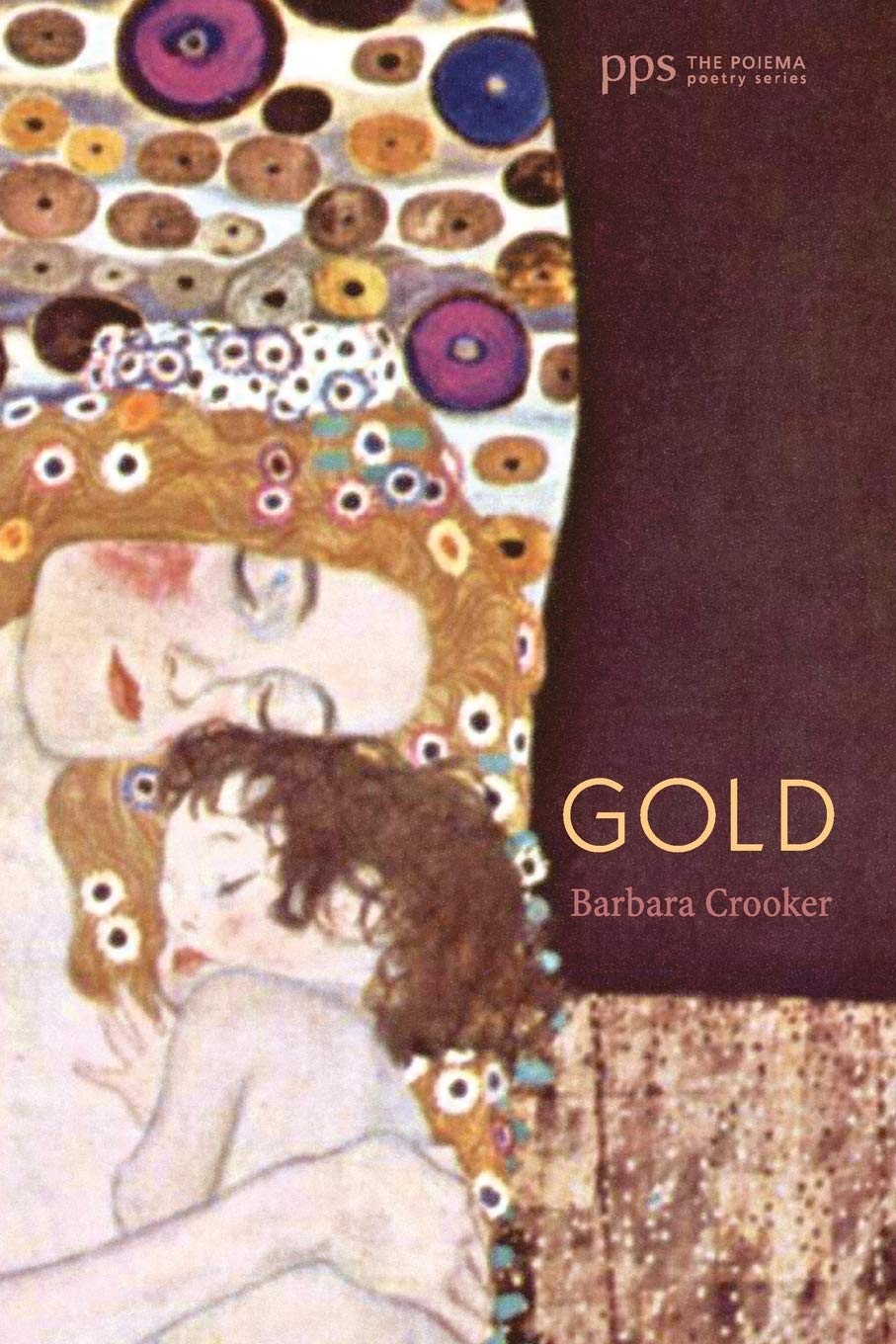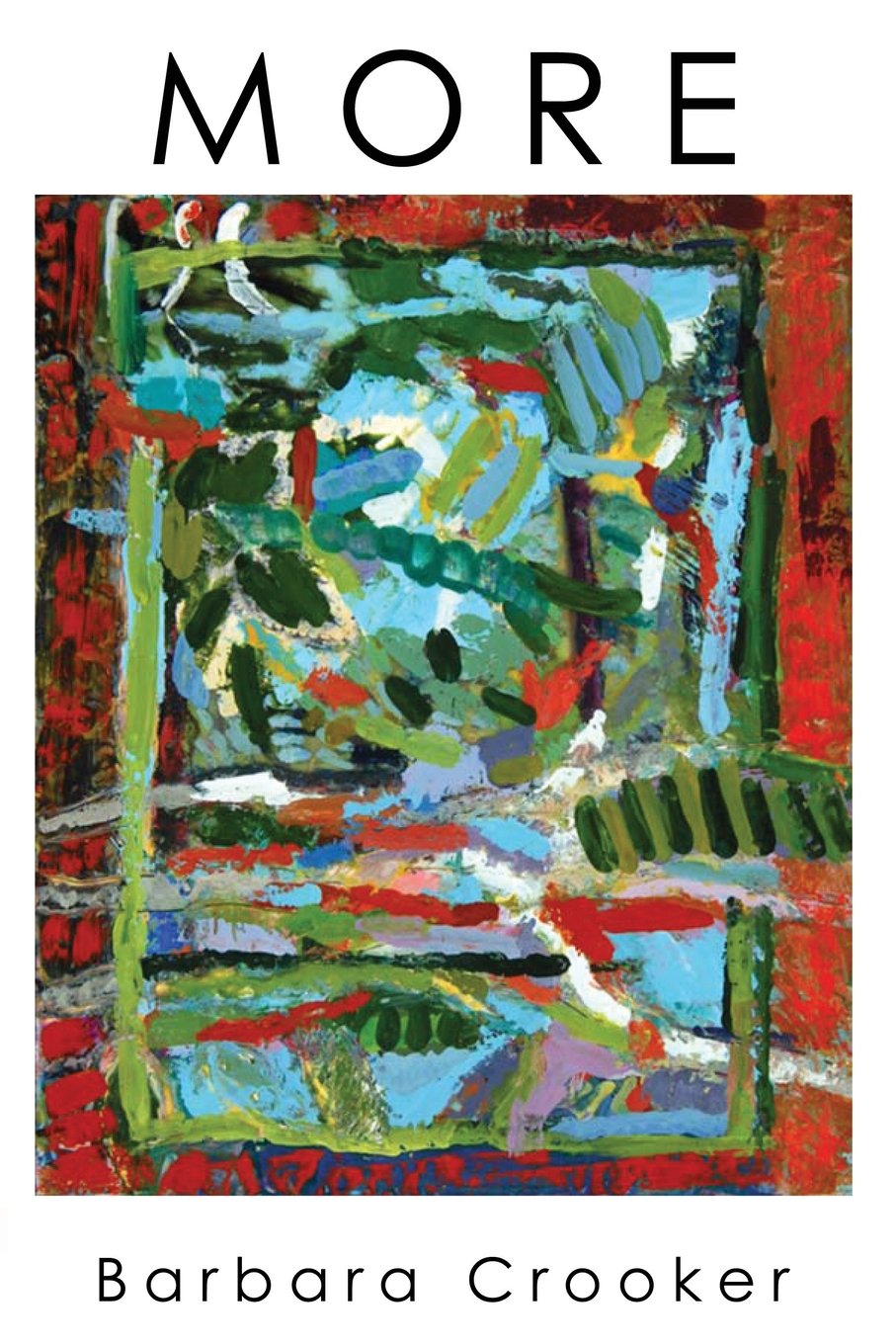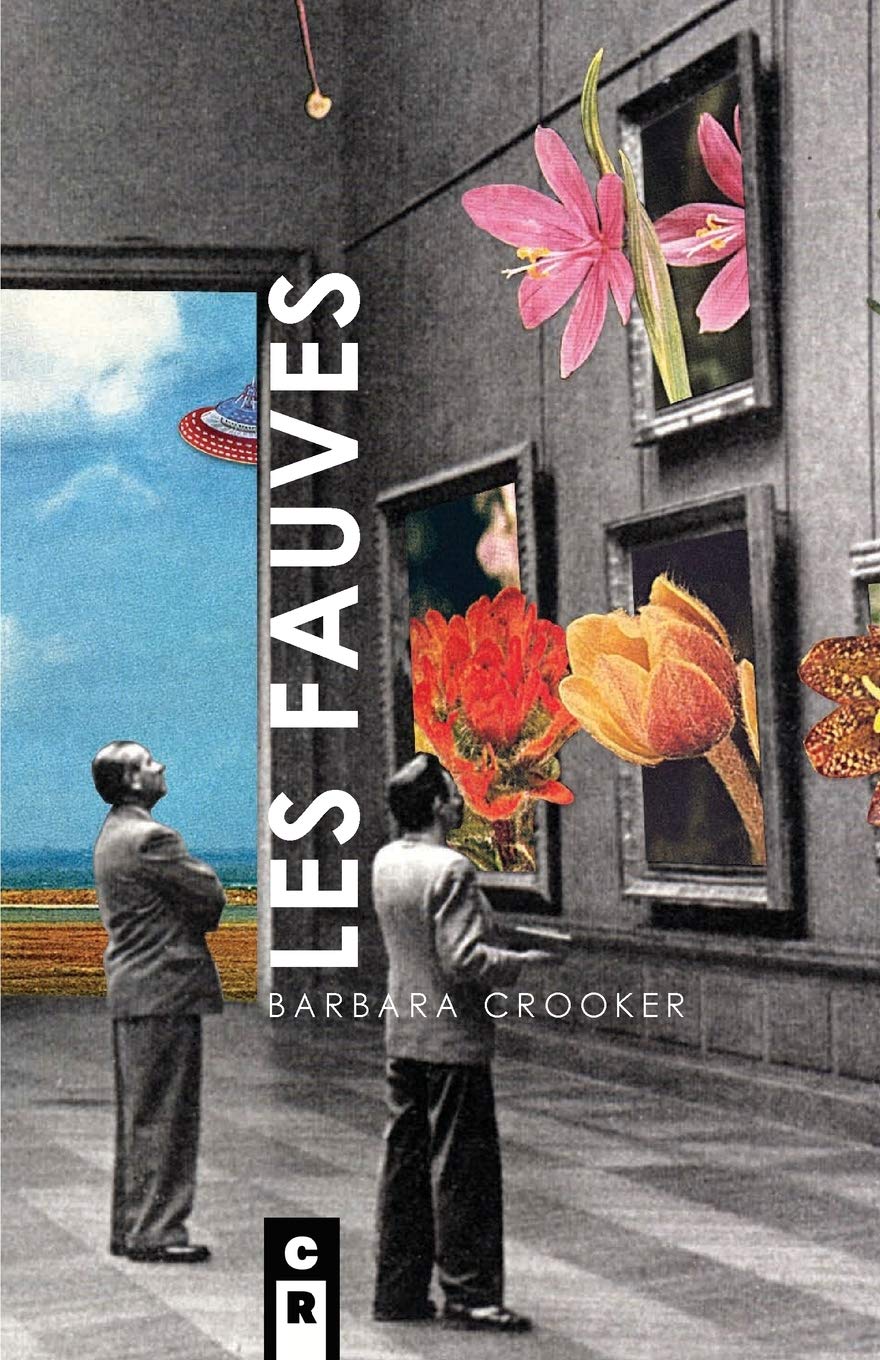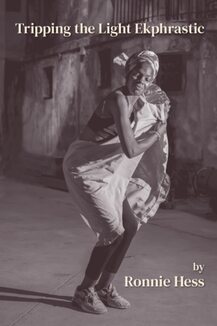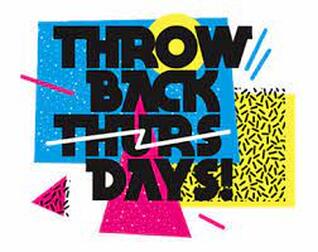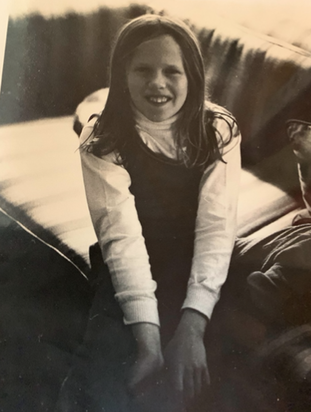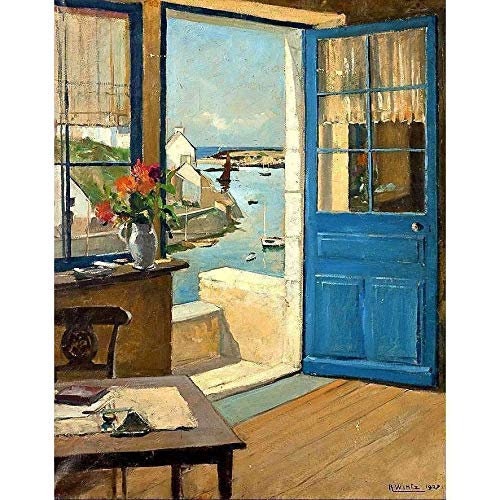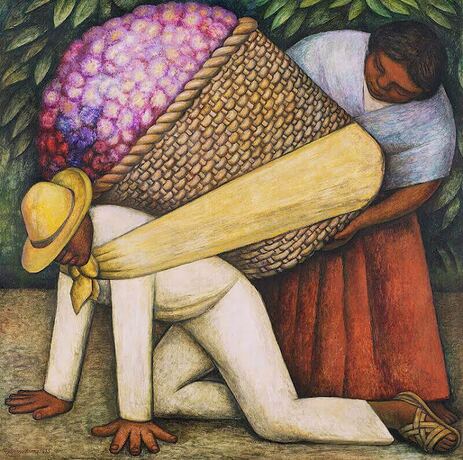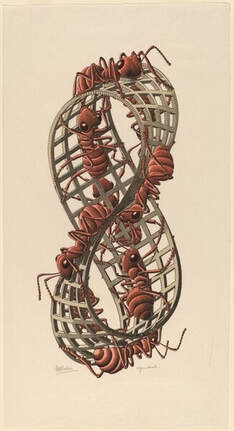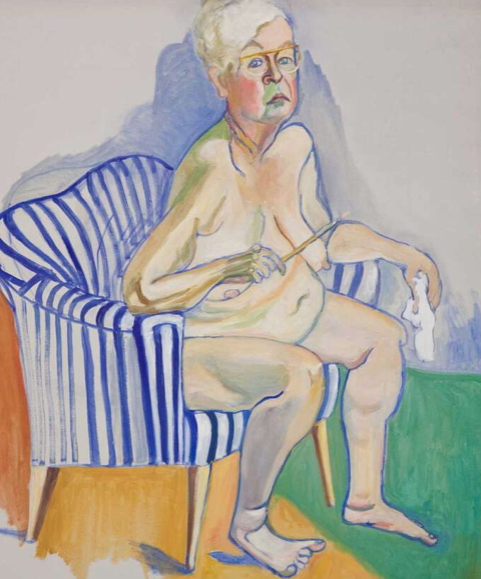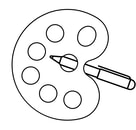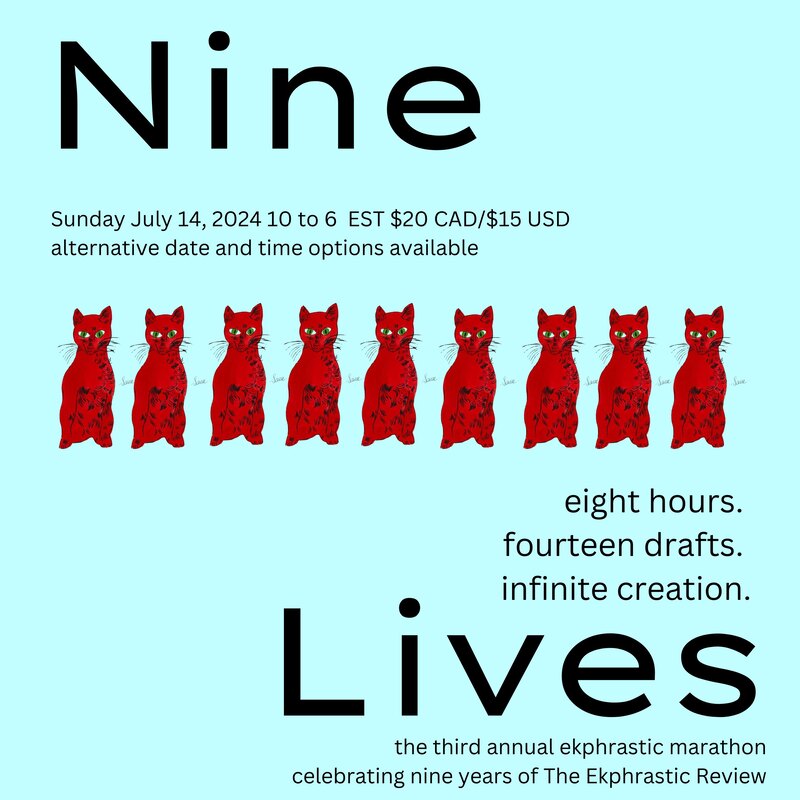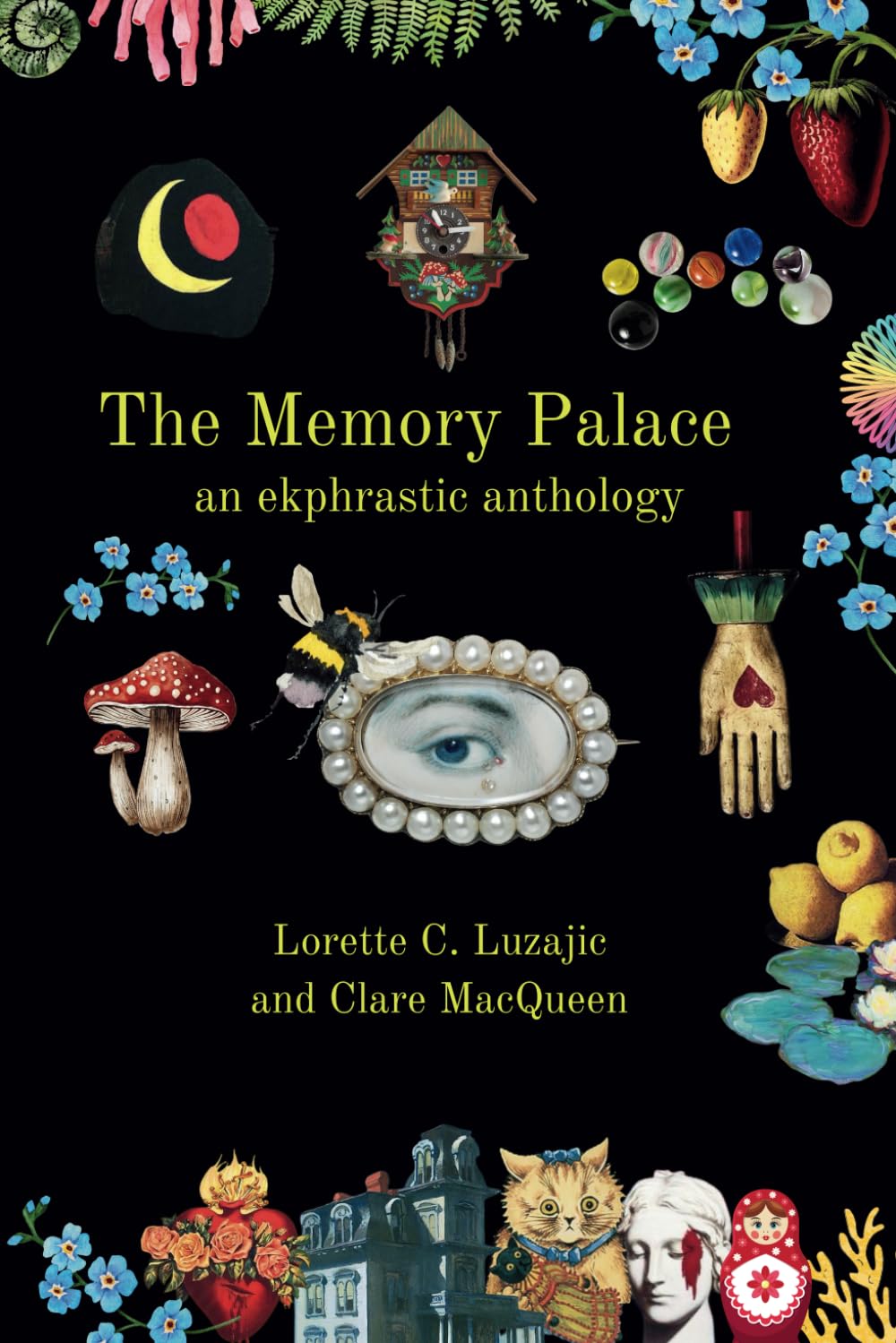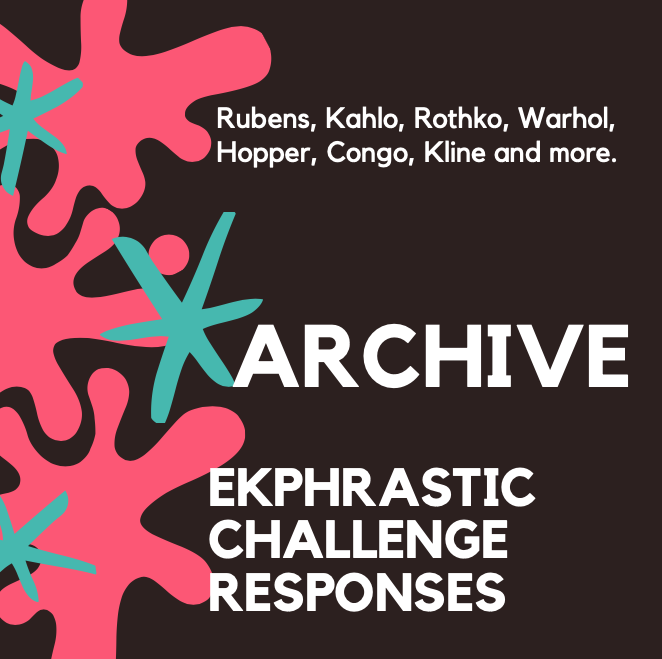|
Two Rivers for RBG I lace and ribbon as jennies must these days. I velvet. But they ill-equip me for this passage. The farrier, too fond of the file, has honed my hooves to a fare-thee-well. The woodworker has whittled my oar to a splinter. Rowing the skiff is like stirring lumpy porridge with a hair. Empty clay pots and a burning house weigh on my back. I’m used to burdens but blurt a protest. The jacks bray louder. They strut and shackle and stunt. Flames lick towards stars, and I aim for the faraway shore. Before we become ash. Before the next commandment. Mikki Aronoff This piece was written in response to The Two Rivers, by El Gato Chimney. View it here. Mikki Aronoff writes in New Mexico. Her work appears in New World Writing, The Ekphrastic Review, MacQueen’s Quinterly, Tiny Molecules, The Disappointed Housewife, Bending Genres, Milk Candy Review, Gone Lawn, Mslexia, The Dribble Drabble Review, and elsewhere. She has received Pushcart, Best of the Net, Best Small Fictions, and Best Microfiction nominations.
0 Comments
Carrie Mae Weems, Self-Portrait The model in the photograph you hold poses in the foreground of an alcove lit with mahogany warmth. She holds a white mirror to one side with her right hand as she brushes her hair back from her face. Her hair is coifed in the style favored by Josephine Baker who danced with Frida Kahlo in the night clubs of the capitals of Europe. Whose long legs swept her along the narrow sidewalks of medieval cities, her pet cheetah tugging at the leash. The blouse and skirt in the photograph were fashioned from a fabric bearing prints of mankind's greatest aspirations. Sequoyah's Cherokee syllabary. The Magna Carta. Martin Luther King's Dream. You want to inspect the lyrics of This Land Is Your Land, but the print is too small. Instead, you admire the way the preambles and psalms resemble a mosaic of jewels each time you step aside or tilt your head at a different angle. The way the outfit flows along the contours of the model’'s body as if the cloth was woven from cascades. She looks into the white mirror, the photographer herself, with persevering beauty. You will never see the mole or the blemishes she imagines. But you will remember the light surging from her dress. And the Rosetta Stone of her life story, which you have just discovered. Michael Brockley This prose poem was written after Carrie Mae Weems' I Looked and Looked but Failed to See What so Terrified You (Louisiana Project series), 2003. Click here to view that photograph. Michael Brockley is a retired school psychologist who worked for 33 years in the schools of northeast Indiana. He lives in Muncie, Indiana where he is looking for a dog to adopt. Over the course of his 73 years, Brockley has companioned five German shepherds and a shih tzu. Since retiring, he has been submitting poems to small market and literary journals. His most recent poems have appeared in Shorts Magazine and Syncopation Literary Journal. Poems are forthcoming in Gargoyle. The Mysterious Affair at Styles Upon closer look, the young English girl in Café Styles was almost a full grown woman. She lifted her eyes from her fashion magazine. One idea, please God, just one bloody idea. Imagined the fame that awaited her once her first novel was written. Dressed in furs and driving a touring car, a Lagonda, as she waved to admirers. A smartly dressed little man caught her eye. His fingertips constantly twirled his waxed moustache. He has ten times more style than any magazine mannequin, she thought. The young woman adjusted the rose which topped her flower-heavy headpiece. A gift from a would-be beau. She continued to fix her gaze on the small, preening man with the perfectly waxed moustache. Suddenly, three words tumbled into her head: little grey cells. Waiter, she called in her most grown-up tone, a pen and paper, if you please. Roberta Beary Roberta Beary identifies as genderfluid and writes to connect with the silenced. After 60 rejections, their prose poem 'After You Self Medicate with Roethke's The Waking Read by Text to Speech App' won the 2022 Bridport Prize for Poetry. The longtime haibun editor at Modern Haiku, they divide their time between the USA and Ireland. Writers find endless inspiration in the curious artworks of Gertrude Abercrombie. Gertrude Abercrombie was a Chicago area surrealist artist. Her intriguing works were filled with recurring personal and universal symbols, such as owls, cats, doors, and moons. Learn more about the artist whose world was jazz and art. We will discuss her themes, paintings, and use her art in several writing exercises. Saturday, February 11, 2023 2 to 4 pm eastern standard time doors open at 1.45 for optional chat and mingle All welcome- poetry, fiction, CNF writers, or just the art curious! Jazz Witch- Gertrude Abercrombie ekphrastic workshop online
CA$30.00
Writers find endless inspiration in the curious artworks of Gertrude Abercrombie. Gertrude Abercrombie was a Chicago area surrealist artist. Her intriguing works were filled with recurring personal and universal symbols, such as owls, cats, doors, and moons. Learn more about the artist whose world was jazz and art. We will discuss her themes, paintings, and use her art in several writing exercises. Saturday, February 11, 2023 2 to 4 pm eastern standard time doors open at 1.45 for optional chat and mingle All welcome- poetry, fiction, CNF writers, or just the art curious! An Interview with Barbara Crooker About Ekphrastic Poetry, by Ronnie Hess Barbara Crooker is the author of many books of poetry, a frequent contributor to the The Ekphrastic Review, and the winner of the 2006 Ekphrastic Poetry Award from Rosebud, among other honours. Some recent books are Some Glad Morning (University of Pittsburgh Press, 2019), The Book of Kells (Cascade Books, 2018), and Les Fauves (C&R Press, 2017). Although Crooker writes about many subjects – love, loss, disability, illness, death – she returns again and again to painting and painters, in a sense redrawing their art with words. Here she shares her ideas about ekphrastic poetry with Ronnie Hess, whose book Tripping the Light Ekphrastic has just been published by Kelsay Books. Ronnie Hess: You’ve written so many ekphrastic poems, Barbara, dozens of them on the The Ekphrastic Review’s web pages, and of course in your books, especially Les Fauves. What is it about painting generally that draws you to speak of them or through them? Barbara Crooker: I think it’s somewhat random, in that I’m not exactly sure what it is that draws me to a particular painting, only that it does, that it’s urgent, and that I need to explore my connection in a poem. With Les Fauves, I was on a writing residency in the southwest corner of France, and so I gave myself the assignment to write about Fauve paintings. I had some favourites in mind beforehand (Matisse, for example), but fell in love with some others as I started working, particularly Raoul Dufy. I got to have two residencies there, so some of those poems also appear in Some Glad Morning. And I had two residencies at the Tyrone Guthrie Centre in Co. Monaghan, Ireland, where I wrote The Book of Kells, which turned a series of ekphrastic meditations on The Book of Kells (among other things), including the materials used, the inks and pigments, the calligraphy, and the various images appearing in the illuminated manuscript. Ronnie Hess: There’s something about the light and colour in the south of France that drew the Impressionists, the Fauvists, but also draws you. Are you partial to French painters? Barbara Crooker: I think I’ve used so many French painters partly because of my travels. My husband worked for a French company (Elf Aquitaine), so we had many trips there together, plus the aforementioned residencies, where I started out with him on vacation first, going to Collioure where Fauvism got started. So, I’ve worked many of the things I’ve loved in my French travels into these poems. And you’re right, the light and colour of the south of France are also compelling. Ronnie Hess: I don’t find many abstract paintings referenced in your poetry. Is this for a reason? Barbara Crooker: So, that’s a really good and really interesting question. I think some of it is because of the random nature of how I work, and also because, with the two French residencies, I took calendars with me for the art, and Impressionist and Post-Impressionist work is figurative. But I chose abstract art for two of my book covers (More, cover by Marilyn Banner and Some Glad Morning, cover by Kristin Herzog). And when I worked on a creative ekphrastic project, I was paired with abstract painter Claire Giblin. This was a really interesting project; we started by selecting something from each other’s websites. Then I did a poem based on one of her paintings, while she did a painting based on one of my poems. Then I did another poem based on her painting, and over and over like an accordion fold. We got to exhibit these together, plus the poets read in a gallery in front of the art. You can find our pairings by scrolling down on her website, www.giblinart.com Ronnie Hess: A few of your poems are sonnets. I’m tempted to say that it’s not just an accident or an appreciation of the sonnet form, but that you want to write a love song. Barbara Crooker: Well, it’s never an accident when I turn to form, but rather, my sense that the poem wants to “dance in a box,” as Rina Espaillat says about the sonnet or wants to explore “the fine art of repeating yourself” in a villanelle (Marilyn Taylor). I try to let the poem lead the way, rather than do something predetermined. I hope that all my poems are love songs. Ronnie Hess: I also get the sense from your ekphrastic poems that the paintings provide not just an impulse, a trigger, or an inspiration but a refuge, even a consolation. Certain lines stand out: “Our days in the sun are brief,” “all the things of the world are about to vanish.” (From “Still Life with Aubergines,” after Matisse, and “Iris,” after Van Gogh.) Barbara Crooker: I think of most of my poems as meditations so refuge or consolation are good descriptors. Again, once inside the world of the painting, I try and stay out of the way of the poem and let it lead me to discover these images and lines. Ronnie Hess: Your poems always reference the painting, and yet there are other poets’ ekphrastic poems that don’t reference the art at all. Rather the poems focus on the emotional response exclusively, or an event in the poet’s life, the art jogging a memory. In short, how would you define ekphrastic poetry today? Barbara Crooker: Poetry’s mansion has many rooms, as does ekphrastic poetry! In other words, there’s no right or wrong way to write an ekphrastic poem. For me, but this is just me, I want an ekphrastic poem to go beyond simply describing the painting or other work of art, but rather, to live in it, and then take us someplace else, a journey of discovery. And ekphrastic poems that don’t reference the art at all are, again, just for me, not especially interesting . . . . Ronnie Hess: I imagine there have always been ekphrastic poems. Writer/Journalist Martin Earl has said, “Painters and poets have been wed from the beginning. Language itself has pictorial roots….Poets are attracted to the symbolic and pictographic traces of their own language in painting.” https://www.poetryfoundation.org/harriet-books/2009/06/poets-and-painters Barbara Crooker: Thank you for this article. In the first couple of paragraphs, one of the things that draws me in (pun intended) is how painters get to use all these great tactile materials: oils, watercolours, brushes, palette knives, etc., while all we writers have are words. . . . Then it discusses pictograms, rebuses, etc.—haven’t we returned to this now, with our emojis and gifs? Where [Russian artist Alexander] Rodchenko declares all painting can be reduced to “pure red, pure blue, pure yellow,” my take is how surely all literature can be reduced to love and loss. And yet there are so many ways both in painting and poetry that we can experience this. Ronnie Hess: Have you had any training in art – in college or later in life? Is there any experience in your life that solidly established a connection with art? [For me, it was in high school in New York – we were required to do a series of museum reports where we chose an artwork, described it and why we liked it.] Barbara Crooker: I have a minor in Art History from Douglass College (once part of Rutgers University) in my undergraduate degree. We were a $2 bus ride from NYC, so I went in often to museums (I had a student membership to the Museum of Modern Art, galleries, etc. I have absolutely no studio training. Once, someone sent me a review they were writing about one of my books, in which this sentence appeared, “As a visual artist, BC really understands the painting process . . . .” I had to write back (fortunately, this review hadn’t been published yet), and set them straight. Clearly, they had never played Pictionary with me! Ronnie Hess: Do you collect art? What artwork or prints might be in your house? Barbara Crooker: I’m not sure “collect” is the right term, but I have a number of prints from museums (I’ve been a member of the Philadelphia Museum of Art), plus ones from visual artists I’ve spent time with at the colony I go to, The Virginia Center for the Creative Arts: Kristin Herzog, Mary Page Evans, Marilyn Banner. Some were gifts, some were purchases. And then a random bunch of things I’ve picked up at yard sales. Ronnie Hess: Is there one piece of art that never tires you, no matter how much you look at it, that always gives you more to think about. Or is there any exhibit that you would travel the world to see, barring COVID, etc. Barbara Crooker: For me, this would be like picking my favourite poem (or picking my favourite child). And I’m so eclectic in my tastes, so all I’ll say is that if I were travelling somewhere, a trip to a museum would be part of my itinerary. I WAS going to St. Petersburg last June and looking forward to visiting The Hermitage. We were worried about Covid; who knew war was on the horizon? Thank you, Barbara, for taking the time to share your ideas about ekphrastic poetry, not to mention your poems, with us! Surface “If you want to know all about Andy Warhol, just look at my films and paintings and me. There’s nothing behind it. That’s all there is.” Andy Warhol It is all surface, isn’t it, the thin blue silk of the sky, an oak leaf’s chlorophyll production line, the unblinking eye of the pond? When I was as shallow as an undergraduate could possibly be, I peeled off from a field trip to Soho galleries to visit The Factory; my friend and I nearly identical in our veneers: ironed hair, wheat jeans, black sleeveless shells, our unwavering scorn of the outside world . . . . It was dazzling, every surface painted silver: the walls, ceilings, tables, chairs, bathroom fixtures, like walking into a roll of aluminum foil. And Andy—thin, spectral, white blond hair, black sunglasses, nearly wordless. Mostly, he just was, the zen of non-being, the art of perfect detachment. And we were mute, too, inarticulate in our youth. We knew what it was we didn’t want, but not what we did. Now, all these years and lives later, the twistings and turnings of many roads— some macadam, some asphalt, some stone— I can’t remember her name, just how straight her hair was, how it hung down her back like a bolt of cloth. In the untidy closet of my heart, I think about what we put on, fashion, facade, how many layers we need between our skin and the rest of the world. Barbara Crooker This poem first appeared in Line Dance (Word Press, 2008). Click here to read many more works by Barbara Crooker in The Ekphrastic Review. Read Ronnie Hess's poem here. Check out books by Barbara Crooker or Ronnie Hess below. Start the new year off right with an array of art and inspired writing. There’s something for everyone in this week’s Throwback Thursday. So, fix yourself a cup of hot chocolate and dive into the experience. Enjoy! … The Lobster, by Diane Durant I love the joining of the writer/lobster in this flash fiction piece. https://www.ekphrastic.net/the-ekphrastic-review/the-lobster-by-diane-durant ** The Sign, by Mary B. Moore A photo of a deteriorated sign in a field and a reminder of the recent and distant past: “sign of madness or ravishment or martyrdom” https://www.ekphrastic.net/the-ekphrastic-review/the-sign-by-mary-b-moore ** The Bird Goes First, by Crystal Condakes Karlberg This poem combines inspiration from images of birds to create one surprising poem. https://www.ekphrastic.net/the-ekphrastic-review/the-bird-goes-first-by-crystal-condakes-karlberg ** Vast, by Phil Vernon Like a fan letter to a favourite artist, this poem asks, “how did you know?” https://www.ekphrastic.net/the-ekphrastic-review/vast-by-phil-vernon ** Migrant Worker on California Highway, by Gail Peck From a 1936 black and white photograph, this lovely poem gives us a traveler who “longs for the reach of apples and peaches, the shade of the trees.” https://www.ekphrastic.net/the-ekphrastic-review/migrant-worker-on-california-highway-by-gail-peck ** Negative Space, by Jay Jacoby A beautiful, reclining, sculpted figure: “hewn shaped scraped.” https://www.ekphrastic.net/the-ekphrastic-review/negative-space-by-jay-jacoby ** In Georgia's Studio, by Jackie Langetieg A painting by Georgia O’Keeffe, a Wisconsin native, propels the reader into the life of the painter. https://www.ekphrastic.net/the-ekphrastic-review/in-georgias-studio-by-jackie-langetieg ** Louis Sullivan, by Timothy Sandefur The first stanza of this poem grabbed me, and this line: “Latent, not free before to manifest in flesh.” https://www.ekphrastic.net/the-ekphrastic-review/louis-sullivan-by-timothy-sandefur There are more than seven years worth of writing at The Ekphrastic Review. With daily or more posts of poetry, fiction, and prose for most of that history, we have a wealth of talent to show off. We encourage readers to explore our archives by month and year in the sidebar. Click on a random selection and read through our history.
Our occasional Throwback Thursday feature highlights writing from our past, chosen on purpose or chosen randomly. We are grateful that Marjorie Robertson shares favourites on a regular basis. With her help, you'll get the chance to discover past contributors, work you missed, or responses to older ekphrastic challenges. Would you like to be a guest editor for a Throwback Thursday? Pick 10 or so favourite or random posts from the archives of The Ekphrastic Review. Use the format you see above: title, name of author, a sentence or two about your choice, or a pull quote line from the poem and story, and the link. Include a bio and if you wish, a note to readers about the Review, your relationship to the journal, ekphrastic writing in general, or any other relevant subject. Put THROWBACK THURSDAYS in the subject line and send to [email protected]. Let's have some fun with this- along with your picks, send a vintage photo of yourself! The Blue Door It was a framed reproduction, but even as that, an extravagance for my parents, for whom spending was always impeccably measured, and The Blue Door was only as big as was needed for a small space over the desk where my mother jotted expenses into her cheap spiral notebooks. I didn’t care about it as a boy, or much more as a young man, but it’s a picture which in memory I love. There are times I imagine myself in her chair, on her corduroy cushion, looking up into those blues. That picture’s been gone for twenty or more years, possibly sold at the garage sale when my mother, my sister and I emptied the house, Mother by then on oxygen, seated behind a card table, re-counting the change in a tin box, slipping the bigger bills into her apron, plastic tube trailing back into the kitchen. Raymond Wintz was the artist. An oil of a seaside interior, with a plain wooden table and chair, and on a narrow shelf under a window a vase with a bouquet of blowsy red flowers. It featured a sea-weathered, chalky blue door that stood open, with a harbour of warmer blues down and beyond. On the table was an open notebook and pencil. The chair had its back turned to the window, as if the person who’d been sitting there hadn’t wanted to be distracted but had since gotten up, and, taking the arm of our mother, had helped her to make her way down the bright steps to the sea. Ted Kooser Ted Kooser is a former U.S. Poet Laureate and Pulitzer winner whe lives in rural Nebraska. His most recent collection of poems is COTTON CANDY; POEMS DIPPED OUT OF THE AIR from U of NE Press. He is also the author of five children's books from Candlewick Press, the most recent of which is a collaboration with poet Connie Wanek, called MARSHMALLOW CLOUDS; TWO POETS AT PLAY AMONG FIGURES OF SPEECH. The Flower Carrier Rivera’s Cargador de Flores shows an expressionless Mexican campesino burdened to earth, in his white cotton work clothes struggling on his knees with an enormous yellow straw basket of pink and purple flowers strapped to his back, pressing down. His huarache sandals planted, he pushes against them, trying to straighten his legs like a pack mule before he lugs the load to market. His wife, larger than life in a full red skirt, stands over him, hand on the basket as if to help, her face barely seen. The painting label, or tombstone, provided by a San Francisco Museum of Contemporary Art curator, reads the portrait "perpetuating the stereotype of Mexico as a tranquil, pre-industrial utopia." But does it? I see a working man weighted with a cargo greater than himself, even larger than his helpful wife. Her face, if it expresses anything, expresses concern the charge is too heavy, that it may crush him, or his foot and their dreams of a bountiful harvest. The quietly desperate scene lacks tranquility. Even the flowers themselves, pretty as they might be, if less shrouded in netting, appear imprisoned. Mike Lewis-Beck Mike Lewis-Beck writes from Iowa City. He has pieces in American Journal of Poetry, Apalachee Review, Blue Collar Review, Cortland Review, Chariton Review, Eastern Iowa Review, The Ekphrastic Review, Guesthouse, Heavy Feather Review, Inquisitive Eater, Pilgrimage, Pennine Platform, Southword, and Wapsipinicon Almanac, among other venues. He has a book of poems, Rural Routes, published by Alexandria Quarterly. Brunelleschi’s Easel Escher incantations spawn geomantic perspective talking heads unravel like onions on TV screens fill cell phone monitors; red ants transverse a helix sandwiched between arrows suggesting choice: one shaft points to heaven where kindly mothers repose and watch over frolicking grandchildren the second cursory dart directs rambling wayfarers to hellfire’s netherworlds—wastelands that absorb inspiration and project false comparison, angles on edge like an infinite clearance traffic sign conceived by illusion’s enigmatic craftsman, promising eternal existence on a Möbius strip organizing scale, arranging space, calling shots, demanding artistic respect like a mathematic dominatrix. Sterling Warner A Washington-based author, educator, and Pushcart nominee for poetry, Warner’s works have appeared in many international literary magazines, journals, and anthologies such as Street Lit., The Ekphrastic Review, Anti-Heroin Chic, The Fib Review, and Sparks of Calliope. Warner also has written seven volumes of poetry, including Without Wheels, ShadowCat, Memento Mori: A Chapbook Redux, Edges, Rags & Feathers, Serpent’s Tooth, Flytraps and Cracks of Light: Pandemic Poetry & Fiction (2022)—as well as. Masques: Flash Fiction & Short Stories. Currently, he writes, turns wood, and hosts virtual poetry readings. A Revolt Against Everything Decent You were fashion-model tall and conspicuously moneyed: your brimmed cloche, the velvet of melting chocolate; your skirt, sleek; stockings, artfully seamed. Far behind you on the museum’s sidewalk, I wanted to see the front of you, certain I’d encounter some inimitable beauty. You paused—posed—back foot weighted, front knee photogenically bent. Were you a pensive heiress visiting your Singer Sargent soul-cousin? A philanthropist on a post-brunch art gaze? On the sun-warmed sidewalk, tourists spoke their native music, soft-swirlers strolled, and skateboarders twisted, airborne. Ticket-holders thronged the edificial glass doors. Amid this genial crowd, I started to heal from the headlines—school shootings and book burnings and librarians crowned with thorns. I sped my step to catch up to you. Inside the museum, on the wall behind clear glass and braided rope, sat Alice Neel, naked but for her eyeglasses and the blue aura of her self-portrait. Her doughy thighs had birthed, her saggy breasts had nursed, and her mouthlines were deep and deliberate. This was no robed Christ-like Dürer at twenty-eight or midlife Monet with brow and beret, but a social realist with a nervy gaze, white hair in a workaday upsweep, a fine brush in one hand, and a smudge wiper in the other, both painter and painted, age eighty. You, however, were fabulously draped. And yet, your sidewalk pace was slow, the camera-necks and stroller-chauffeurs parting seas around you. Your evening lipstick was bold at high noon; your rose-gold curls, silken; conservations visible at six inches, but not six feet. Your pose had been regal, but your steps teetered. Had brunch featured a tequila-melon puree--or three? More likely, it was the four-inch heels; hazardous at forty as you seemed from a distance; treacherous at eighty, as I saw up close. Only recently, my sparkling, sneaker-footed, octogenarian mom took a fall that brought her a cane. My walks-a-lot cousin in-law fell in Central Park and was hospitalized with hip and pelvis fractures. A family friend toppled from a curb one afternoon and into a wheelchair for the rest of her life. Surely, you, too, had such a roster. How then could the joint-jamming clip-cloppers be worth the risk? Adept at dread, I’m ever surprised by its absence in others. Paused, your profile was as proud as a queen on a coin and I sensed that my offer of an arm would have offended. I wish only that I’d been able to revel in your refusal to dress your age, and simply allow your striking self-portrait, like the naked Alice, to startle and sate and render me fearless. Lisa K. Buchanan Writings by Lisa K. Buchanan have appeared in many journals, including CRAFT, Hippocampus, The Lascaux Review, and Sweet. She likes dancing the Charleston, slurping up black rice with butternut squash, writing letters to strangers, and breaking the Rule of Three. www.lisakbuchanan.com. The title of this piece is from a remark Alice Neel reportedly made about her self-portrait, “Frightful, isn't it? I love it. At least it shows a certain revolt against everything decent.” (Source: The Mirror and the Palette, Jennifer Higgie, Pegasus Books, 2022) |
The Ekphrastic Review
COOKIES/PRIVACY
This site uses cookies to deliver your best navigation experience this time and next. Continuing here means you consent to cookies. Thank you. Join us on Facebook:
July 2024
|
